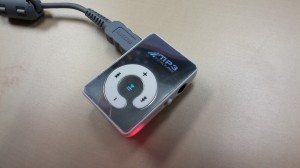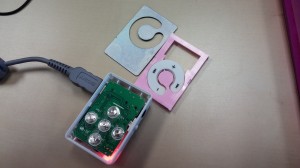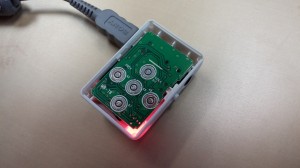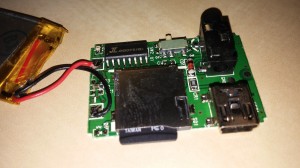Teardown: $1.45 Chinese MP3 Player
As happens on a fairly regular basis these days, the two- to six-week shipping wait came to an end last night for another so-cheap-as-to-be-questionable eBay electronics purchase from China or Hong Kong. This time, it was an item called “New Mini Mirror Clip Mp3 Sport Music With TF-Card[1] Slot Up To 8GB”. I purchased two of these for $1.45 each, shipping included, with the intention of cracking them open and controlling them using a microcontroller[2], but also with the knowledge that even the non-MP3 parts, including a 3.5mm stereo jack, a USB mini-B jack, a microSD slot, a little rechargeable battery, and maybe some other goodies, would justify the already trifling cost as scrap.

Backed by a $5 memory card and a USB cable from a far more expensive Sony music player, this tiny device somehow fails to be irrelevant.
Before I went to work on taking it apart, I set about making sure the thing actually worked. Because I didn’t have a card adapter handy, I used the USB interface on the device itself. It’s not fast by any stretch of the imagination—I think it actually uses USB 1.1 (and, after having looked at the guts, I’m guessing the low-speed SPI interface on the card). I put on files in four formats—MP3, WAV, Ogg, and FLAC—in order to determine what it would actually play.
The results are these: Only the MP3 file played. After changing the extensions on the other files to .mp3, the WAV file also played, but the others were still skipped. And while the output of the audio content itself was adequate, there was substantial background noise carried over from the rest of the circuit. For under $8 including the shipping and the memory card, we’re not expecting a hi-fi or even an iPod shuffle—but this is a reminder that we’re working with something suitable for little more than a toy. And that’s okay, because the less shady version of an MCU-controlled MP3 decoder will set you back $40 from a finer (and more legitimate-feeling) retailer.
No screws were visible on the device, so I set about coercing it apart by running my thumbnail down a seam on the face. As you can see, it was more than cooperative. (That said, I think it would take a non-trivial impact for it to come apart on its own.)
The mirror face is actually kind of like a sticker with a backing having roughly the malleability of thin sheet aluminum. It was stuck by a tacky adhesive to the back of the face, which was a slightly thicker piece of pink plastic.
The rest of the face comes off easily, revealing the PCB with five tactile domes (the kind that deform under your finger and make an obvious click when depressed) taped in place.
Under each dome are concentric outer and inner contacts on the PCB; pressing the dome connects the center to the surrounding ring, registering a button press.
Freeing the PCB from the case was slightly more than my thumbnail could muster, so I used a prong from the plug end of a phone charger I had handy. As before, it was only lightly stuck into place and required only trivial force to remove.
The internals of this thing, at least from what I can see without desoldering anything, are amazingly simple. Other than a number of discretes countable on one or two hands, you have the battery, the microSD slot, the stereo jack, the USB jack, a very small switch (I think SPDT), and the main event—an SOIC-16 chip running the whole show.
The latter is marked with a logo that looks like somewhere between “JL” and “π”, followed by the cryptic legend “AB1426CF3Y13.1-83En” for which Google proves useless to make any connection.
Several of the pins on the microSD card are kept intentionally disconnected (there even appears to be a bit of silkscreen to prevent their accidental connection), which is why I think the SPI mode (which uses fewer pins than the full-speed modes) is in use.
Anyway, the whole thing is actually surprisingly simple connection-wise (a good deal less complex than the player in original Instructable). I kind of wonder if I could perhaps get the whole thing desoldered, reverse-engineer a schematic, and put it back together in a way that would have fewer noise issues.
Fun.
- [1]TransFlash, or “TF”, is an outdated name for microSD. Given that microSD is far more recognizable, and that an 4GB or 8GB card is not even plain microSD but microSDHC, I have no idea why they’d call it by this name.↩
- [2]in a similar fashion to this Instructable which uses a somewhat more expensive but mostly identical player↩






